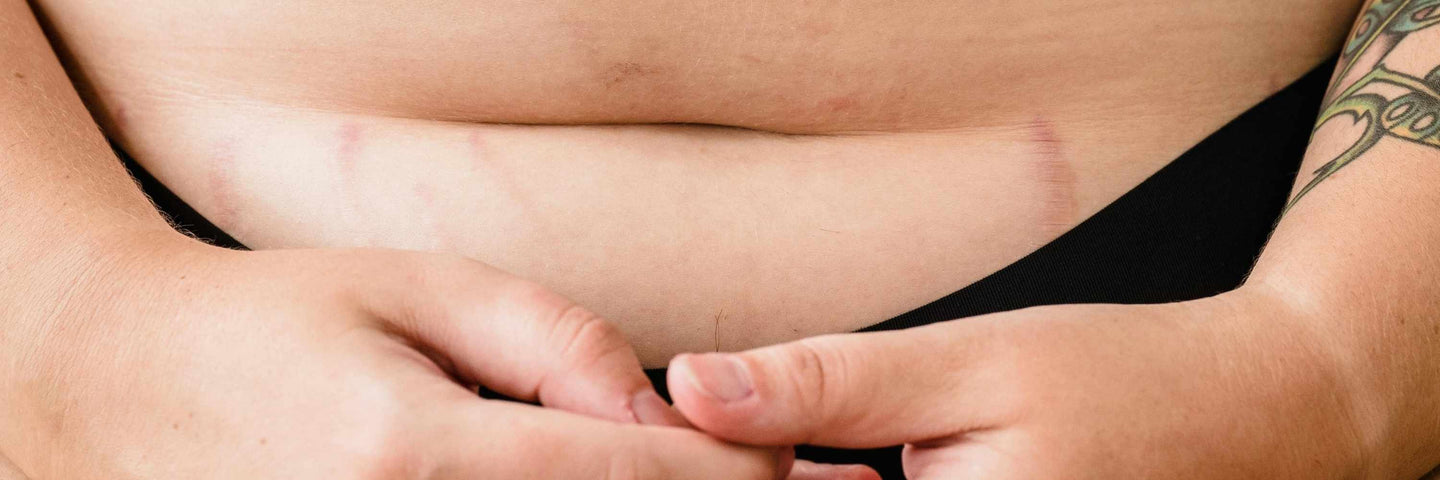
Find a flat stomach after childbirth
Verified on 7/21/2025
Bienvenue chez Gapianne ! 👋
Ici, nous guidons les femmes vers des solutions adaptées sur toutes les questions liées à leur santé gynéco et leur bien-être intime, grâce à un parcours d’accompagnement personnalisé.
Table of contents
- Pregnancy, a test for the body
- The evolution of the belly during pregnancy and after childbirth
- How to prepare your belly for pregnancy?
- Getting your belly back after giving birth is a process that requires patience.
- How can I get my pre-pregnancy belly back?
- Despite everything, I can't get my pre-pregnancy stomach back, what should I do?
The postpartum belly can be a touchy subject for some moms. The postpartum period is a unique and transformative time in a woman's life. It's the time when you gave birth to a miracle of nature, but it's completely natural to want to get your pre-pregnancy belly back . However, it's crucial to understand that this recovery process must be approached with patience, kindness to yourself, and realistic expectations.
In this article, we'll explore healthy and effective ways to get a flat stomach after giving birth , with a focus on both physical and mental health. Enjoy!
Pregnancy, a test for the body
Pregnancy is undeniably a challenge for a woman's body, especially the abdominal area.
For nine months, the abdomen stretches to accommodate the growing fetus, which can lead to tension and pain. In addition to these changes, the body undergoes a series of profound physiological transformations to accommodate and nourish the unborn baby. The uterus stretches , hormones fluctuate, and the body stores fat to support the pregnancy.
These changes are normal and necessary, but they can also be challenging. Back pain, nausea, fatigue, and discomfort are all common symptoms that accompany pregnancy.
However, these physical challenges are also a testament to the strength and resilience of the female body, capable of creating life. The postpartum period, when the body begins to recover, represents an important step in regaining balance and fitness in the womb. It's a demanding journey, but remember that it's marked by the beauty of motherhood and the power of the female body!
The evolution of the belly during pregnancy and after childbirth
During pregnancy
There's no doubt that the belly is at the heart of the physical transformation that accompanies pregnancy. Over the course of nine months, it undergoes remarkable changes. It reflects the body's extraordinary growth and adaptation to accommodate and support life. Let's take a look at the changes it undergoes.
Stretching the uterus:
One of the most visible changes is the expansion of the uterus. As the fetus grows, the uterus stretches to provide enough space for it to develop. It is from this point that the pregnant belly begins to appear.
Skin stretching:
The skin on your stomach also undergoes changes . It can stretch considerably to accommodate the growing uterus and baby. This can cause stretch marks , pink or purple skin lines that form when the skin stretches rapidly.
Abdominal swelling:
Water retention, increased blood circulation, and pressure from the growing uterus can contribute to some abdominal swelling.
Nitra line:
The linea nigra is a dark line that can appear on the belly during pregnancy. It is caused by increased skin pigmentation and is generally more visible in some pregnant women. This line tends to fade naturally after delivery, but it can persist for some women for a while.
After childbirth
After giving birth, the belly begins to return to its original shape . However, before returning to its original shape, it goes through several stages!
Contraction of the uterus:
After childbirth, the uterus begins to contract back to its normal size. During this time, the abdomen may feel softer and less taut than before pregnancy.
Stretch marks:
Stretch marks may persist after childbirth, but they tend to fade over time and become less visible.
Abdominal relaxation:
After childbirth, the abdominal area may feel looser due to loss of muscle tone. Abdominal and pelvic floor muscles may be weakened due to stretching during pregnancy and pressure during childbirth.
Possible diastasis recti:
Some women develop a separation of the abdominal muscles, called diastasis recti, where the rectus abdominis muscles separate. This can create a "hollow" or sagging feeling in the abdominal area.
Weight loss:
Postpartum weight loss can also affect the appearance of the belly. As a woman loses weight, the fat accumulated during pregnancy decreases, which can help reduce belly size.
How to prepare your belly for pregnancy?
What if we started at the beginning? As the saying goes, "An ounce of prevention is worth a pound of cure," and this maxim is perfectly applicable to our situation.
Preventing stretch marks during pregnancy can be a major concern for many women. While there's no 100% guarantee against stretch marks, there are steps you can take to reduce their appearance.
Here are some tips to prevent stretch marks during pregnancy:
Moisturize your skin:
Well-hydrated skin is more supple and less prone to stretch marks. Use a moisturizer or oil specifically formulated for pregnant women, as they tend to be richer in ingredients that help prevent stretch marks. Apply it regularly, especially to areas at risk, such as the stomach, hips, breasts, and thighs.
✨ At Gapianne, we particularly appreciate the Talm postpartum pregnancy balm, specially designed to prevent the appearance of stretch marks. Why do we love it? Because its formula is 100% clean, organic, and vegan. And customers love it! Just look at the comments 🙂 If you prefer oils, try the pregnancy and postpartum oil from the same brand, which is just as great!
Maintain a healthy weight:
Stretch marks are caused by rapid weight gain. Gradual and controlled weight gain during pregnancy can help reduce skin tension, reducing the risk of stretch marks. Consult your healthcare professional to determine a weight gain plan appropriate for your situation.
Eat a balanced diet:
Eating a diet rich in nutrients, vitamins, and minerals can promote healthy skin. Make sure you're getting enough vitamins A, C, D, and E, as well as zinc, which are beneficial for skin.
Avoid scratching your stomach:
Don't scratch itchy areas, as this can damage the skin and promote the development of stretch marks. Instead, use soothing moisturizers or ask your healthcare professional for advice.
✨Do you have itchy skin? Try our favorite product: the Talm roll-on (yes, we love this brand) which helps moisturize and soothe itchy stomachs.
Wear loose, comfortable clothing:
Tight clothing can rub against the skin and increase the risk of stretch marks. Choose loose, comfortable clothing to reduce friction.
Be patient:
Stretch marks can appear despite all prevention efforts. It's important to remember that they will usually fade over time and become less visible. You can also consider dermatological treatments to reduce their appearance if necessary, but consult your doctor first.
By following these tips and taking good care of your skin, you can help minimize the risk of stretch marks during pregnancy. However, keep in mind that every woman is different, and it's completely normal to have some stretch marks. They are a testament to a special time in your life: the creation of a new life!
Getting your belly back after giving birth is a process that requires patience.
Postpartum belly recovery is a process that requires one essential quality: patience. There's no point in rushing, and it's especially important to take it easy and avoid putting unnecessary pressure on yourself.
As we have just seen, during pregnancy, the body undergoes a series of significant physiological changes, including the expansion of the uterus, the stretching of the skin, and the weight gain necessary to support the unborn baby.
After childbirth, the uterus should return to its normal size through uterine involution, while the abdominal and pelvic muscles may be weakened. Weight loss, especially that accumulated during pregnancy, is a gradual process.
It is also important to know that recovery speed varies depending on many factors!
Recovery speed varies depending on several factors
The length of time it takes to regain your belly after childbirth can vary greatly from woman to woman, depending on several factors. Typically, it can take anywhere from a few months to a year or more for your belly to return to a shape similar to its pre-pregnancy state. Factors that influence how long this process takes include:
- Type of delivery: Women who have had a cesarean delivery may require additional recovery time due to abdominal surgery.
- Genetics: Genetics plays a significant role in how the body recovers after pregnancy. Some women are predisposed to regaining their shape faster than others.
- Physical activity: Women who regularly engage in appropriate postpartum exercises can help strengthen their abdominal muscles faster.
- Proper nutrition: A healthy, balanced diet, along with adequate hydration, can promote faster recovery.
- Number of previous pregnancies: Women who have had multiple pregnancies may find that it takes longer for their belly to recover after each pregnancy.
⚠️Remember that every woman is unique, and there is no set timeline for postpartum belly recovery. It's important to take the time needed to allow your body to recover in a healthy and sustainable way, without comparing yourself to unrealistic standards. Priority should be given to your overall health and well-being, with a realistic and patient approach.
So no matter how long it takes you to get back to your original belly, it's okay! Your body is beautiful just the way it is. You created life, learn to cherish it ❤️.
How can I get my pre-pregnancy belly back?
The importance of breastfeeding
Unbelievable, but true! Breastfeeding plays a significant role in the recovery process of the womb after childbirth. It promotes uterine contraction thanks to the oxytocin released during breastfeeding, which helps return the uterus to its normal size more quickly.
This uterine contraction can help firm the abdominal area, albeit gradually. Additionally, breastfeeding requires energy expenditure, which means you're burning extra calories while feeding your baby (yes, ladies!).
However, it's important to emphasize that breastfeeding isn't the primary weight loss strategy. But it does contribute to healthy weight loss.
Moreover, breastfeeding is not only physically beneficial; it also provides a wonderful opportunity to bond deeply with your baby, strengthening your relationship. It is essential to remember that the choice between breastfeeding and bottle-feeding is personal, and what matters most is the well-being of both mother and baby. Choose the feeding method that best suits you and your baby's needs, while also considering your own health and comfort.
CTA: Discover all our products to facilitate breastfeeding >
Also read: 12 galactogenic foods to stimulate lactation >
Do physical activity when you feel ready
After giving birth, proper physical activity can be a key part of your recovery process. Here are some types of postpartum exercises to consider, each with its own specific benefits for belly recovery:
- Cardiovascular exercise: Moderate cardiovascular exercise, such as walking or swimming, can help burn calories and promote overall weight loss. However, start slowly and gradually increase the intensity to avoid overtaxing your body.
- Muscle strengthening exercises: Targeted muscle strengthening exercises can help tone the muscles in your abdominal area. Basic exercises, such as modified crunches or planks, can be gradually incorporated into your routine. Be sure to follow proper guidelines to avoid unnecessary strain.
- Yoga and Pilates: Yoga and Pilates are excellent options for improving flexibility, posture, and core strength. They also emphasize breathing and body awareness, which can be beneficial for postpartum recovery. If you'd like to do it for free at home, we recommend the following video by Delphine Bourdet, a post-pregnancy yoga instructor.
Prioritize a balanced diet and stay hydrated
We're probably going to harp on this a bit, but nutrition is a fundamental pillar of postpartum recovery and getting your pre-pregnancy belly back.
Choose a balanced diet rich in essential nutrients such as protein, complex carbohydrates, healthy fats, vitamins, and minerals. Control your portions to maintain a proper calorie balance and avoid overindulging.
Hydration is equally crucial whether you're breastfeeding or not, as it promotes recovery, healthy skin, and appetite regulation. Fresh fruits and vegetables provide essential nutrients and fiber for healthy digestion.
Avoid processed foods high in sugar, saturated fat, and salt. It's important to consult a healthcare professional before embarking on a restrictive weight loss diet, as every woman has individual needs.
By eating a healthy diet and staying hydrated, you'll support your recovery and well-being while gradually working towards regaining your pre-pregnancy figure in a healthy and sustainable way.
Wear a postpartum belt
To get your pre-pregnancy belly back, consider a postpartum belt 😊. This postpartum support belt offers several essential benefits.
First, it provides crucial support to the abdominal area, which may have been weakened during pregnancy. This can help reduce discomfort and provide a sense of stability, especially if you've had a cesarean section or if your abdominal muscles are stretched.
Additionally, the belt provides welcome lumbar support, relieving lower back tension often associated with pregnancy. Its gentle compression helps reduce abdominal bloating, a common symptom after childbirth.
By wearing this belt, many women find increased physical comfort, which is especially valuable during the recovery period.
Finally, it can also have a positive impact on self-confidence by promoting a more toned appearance.
However, it's important to note that the postpartum belt isn't suitable for everyone, and it's recommended that you consult a healthcare professional before using it to ensure it's appropriate for your specific situation. Whether you choose to wear it depends on your personal comfort and individual needs during the postpartum recovery period.
Do a lymphatic massage (Renata method)
Lymphatic massage is a gentle massage technique that can be extremely beneficial in the postpartum recovery process, particularly in restoring a pre-pregnancy stomach. That said, we recommend the Renata method, performed by a professional, such as an osteopath. Here's how this approach can play an important role:
- Swelling Reduction: After childbirth, many women experience some abdominal swelling. Lymphatic massage targets the lymphatic system, which is responsible for removing toxins and excess fluid from the body. By promoting lymphatic circulation, this type of massage can help reduce swelling in the abdominal area, allowing the stomach to appear more toned.
- Improved Blood Circulation: Lymphatic massage can also improve blood circulation in the abdominal area. Optimal blood circulation promotes better tissue oxygenation and faster recovery.
- Stress and tension relief: The postpartum period can be stressful, and lymphatic massage offers deep relaxation. By reducing stress and tension, it can contribute to a faster recovery and promote overall well-being.
- Stimulates digestion: Healthy digestive function is crucial for effective recovery. Lymphatic massage can stimulate the digestive system by promoting intestinal peristalsis, which can help prevent constipation and maintain a flatter stomach.
Try physiotherapy
Physiotherapy, also known as kinesitherapy, is a medical discipline that uses rehabilitation and muscle strengthening techniques to promote physical recovery. After childbirth, physiotherapy can be a valuable asset in helping women regain their pre-pregnancy belly.
Targeted muscle recovery is one of the pillars of physiotherapy intervention. After childbirth, abdominal and pelvic muscles can become weakened and stretched. Physiotherapy offers a series of exercises specifically designed to strengthen these muscles. This muscle rehabilitation not only promotes abdominal recovery, it also stimulates calorie expenditure. Strengthened muscles naturally burn more calories, thus significantly contributing to weight loss.
Improving posture, another crucial aspect of physiotherapy, also deserves special attention. Poor posture can exacerbate abdominal and lower back problems, while also altering the appearance of your belly. Physiotherapists are highly qualified to assess your posture and provide personalized adjustments. These postural corrections play a key role in flattening your belly while minimizing back pain, creating the ideal conditions for regaining your pre-pregnancy figure.
Be patient and learn to love your belly ❤️
Remember that postpartum belly recovery is a gradual process that varies from woman to woman. Be patient with yourself and don't compare yourself to others. Learn to love and appreciate your body, for it has accomplished a wonderful creation: the birth of your baby. ❤️
Despite everything, I can't get my pre-pregnancy stomach back, what should I do?
It's perfectly normal for postpartum belly recovery to vary from woman to woman. If, despite your best efforts, you're having trouble getting your pre-pregnancy belly back, don't despair. Every body is different, and it's essential to respect your own pace.
At such times, it may be wise to consult a healthcare professional, such as a postpartum physiotherapist, who can assess your individual situation and design a tailored recovery plan.
Never forget that your beauty is not measured by the size of your belly, but by the strength, resilience, and love you carry within. You are an extraordinary mother, and your body deserves all the respect and gratitude in the world.
You might be interested in these articles:
8 BREASTFEEDING POSITIONS TO TRY
ALL YOU NEED TO KNOW ABOUT BREASTFEEDING CRACKS
RETURN OF PERIOD EVERYTHING YOU NEED TO KNOW ABOUT THE RETURN OF PERIODS
Bienvenue chez Gapianne ! 👋
Ici, nous guidons les femmes vers des solutions adaptées sur toutes les questions liées à leur santé gynéco et leur bien-être intime, grâce à un parcours d’accompagnement personnalisé.




